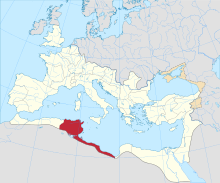
Vazari-Didda or Vazari Didda) was an Ancient city and bishopric in Roman Africa, which remains a Latin Catholic titular see.
Contents
Its presumed modern site is Henchir-Badajr, in present Tunisia.

Vazari-Didda or Vazari Didda) was an Ancient city and bishopric in Roman Africa, which remains a Latin Catholic titular see.
Its presumed modern site is Henchir-Badajr, in present Tunisia.
Vazari-Didda was important enough in the Roman province of Africa Proconsularis to be one of Carthage's Metropolitan archbishopric's. Vazari-Didda, perhaps identifiable with Henchir-Badajr in today's Tunisia, remains an ancient episcopal titular see of the Roman province of Africa Proconsularis, and a suffragan of the Archdiocese of Carthage.
Among the bishops at the Council of Carthage (411), between the Catholic and Donatist bishops of Africa, was one Adeodatus, described as Publianus episcopus Bazarididacensis plebis, who declared to have no Donatist competitors in his diocese. [1]
There was actually a certain Calipodius who was physically present in the dioces, but when he saw that this whole congregation converted to Catholic Church , he simply left the place. [2]
However, Adeodatus title, is of uncertain identification and the geographic location of his bishopric is also uncertain in the documents.
Today Vazari-Didda survives as titular see, and the current bishop is Engelberto Polino Sánchez, auxiliary bishop of Guadalajara Jal.
Vazari-Didda was the seat of an ancient bishopric also known as Vazari-Didda. [3] [4] The Diocese was nominally restored as Latin Catholic titular bishopric in 1933. [5]
It has had the following incumbents, of the lowest (episcopal) rank with an archiepiscopal (intermediary rank) exception :
Known Bishops

The name early African church is given to the Christian communities inhabiting the region known politically as Roman Africa, and comprised geographically somewhat around the area of the Roman Diocese of Africa, namely: the Mediterranean littoral between Cyrenaica on the east and the river Ampsaga on the west; that part of it that faces the Atlantic Ocean being called Mauretania, in addition to Byzacena. Thus corresponding somewhat to contemporary Morocco, Algeria, Tunisia and Libya. The evangelization of Africa followed much the same lines as those traced by Roman civilization. From the late fifth and early sixth century, the region included several Christian Berber kingdoms.
Obba was an Ancient town in Roman North Africa. It is now a Latin Catholic titular see.

Menefessi is a former ancient city and bishopric in Tunisia. It is currently a Latin Catholic titular see.
Musti in Numidia, also called Musti Numidiae, was an ancient city and bishop jurisdiction (bishopric), and is presently a Catholic titular see,(bishop's government see of a former government under a church's responsibility, also known as a dead diocese.) in modern Algeria.

Aquae in Proconsulari is a former Ancient city and bishopric in Roman Africa and present Latin Catholic titular see.
Ausuaga is an ancient city and former bishopric in Roman Africa. It is currently a Latin Catholic titular see. Its present location is somewhere in modern Tunisia.
Villamagna in Proconsulari was a town in the Roman province of Africa Proconsulare. It is identified with the modern village of Henchir Mettich located around 50 km from Carthage in Tunisia.
Henchir-Tebel is a town and archaeological site in Al Qayrawān, Tunisia, near Kairouan

Vallitanus or Vallis was an ancient Roman–Berber colonia in Carthage, Tunisia. The town is identified with ruins at Sidi Medien, where are located the remains of a Roman theatre, and a number of Roman inscriptions bearing witness to the town's name, and some local officials of the time can be found near the theatre.

Semta was a Roman era Municipium also known as Augustum Semta in Africa Proconsularis that is tentatively identified with ruins at Henchir Zemba (Dzemda) Carthage, Tunisia near the Oued el Kebir 20 km (12 mi) southwest of Zaghouan at 36.269282, 9.887345.

Siccenna was a Roman Era town and episcopal see in the Roman province of Africa Proconsularis in what is today northern Tunisia, which is now a Latin Catholic titular bishopric.
Cellae in Proconsulari was an ancient city and bishopric in Roman Africa, which remains a Latin titular see.

Cissita was a town and bishopric of Roman North Africa, which only remains as a Catholic titular see.

Simidicca, was a Roman era civitas of the Roman province of ' Africa Proconsolare.
Bordj-Bou-Djadi is an archaeological site and former Catholic diocese located on the outskirts of Tunis, Tunisia. The area is situated near Ucres, at 36.901123n, 9.97083e. It is now a Latin Catholic titular see.

Utimma was an ancient city in the Roman province of Africa Proconsularis during the Byzantine and Roman Empires. the exact location of Utimma is lost to history but it is believed to be between Sidi Medien and Henchir-Reoucha in Tunisia.
Henchir-El-Meden is a locality and archaeological site in Tunisia.
Henchir-Khachoum is a locality and series of archaeological sites in Sidi Bouzid Governorate modern Tunisia. The ruins are strewn along a tributary of the Oued El Hatech river east of Sbeitla. During the Roman Empire there was a Roman town of the Roman province of Africa Proconsularis, called Muzuca, one of two North African towns to bare that name.
Baia was an ancient city and bishopric in the Roman province of Africa Proconsulare. It is a Roman Catholic titular see.
Cilibia was an Ancient city and bishopric in Roman North Africa, which remains a Latin Catholic titular see.
10.El Papa nombró el viernes nuevos Obispos para Guadalajara. https://www.ejecentral.com.mx/el-papa-francisco-nombro-el-viernes-nuevos-obispos-para-guadalajara/